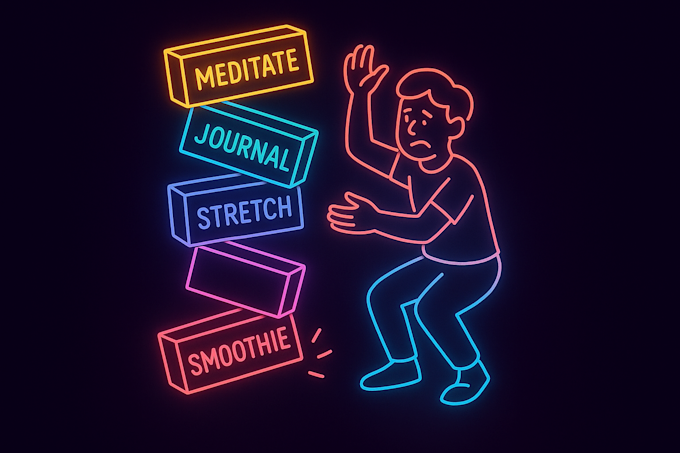
Why Most People Fail at Habit Stacking
Aug 24, 2025
By Will Moore
You tried it. Monday motivation hits and you decide to stack meditation onto your morning coffee routine. "After I pour coffee, I'll meditate for 5 minutes." By Thursday, you're mindlessly scrolling your phone with your coffee instead. By next Monday, meditation is forgotten.
If this sounds familiar, you're not alone. Most people abandon habit stacking within a week. The problem isn't your willpower—it's how you're using the technique.
The Three Fatal Mistakes
Mistake #1: Stacking Too Many Habits at Once
You decide to transform your entire morning routine at once. Journaling, meditation, stretching, and making a protein smoothie all get stacked onto your existing habit of checking emails. Your brain can only automate one new behavior pattern at a time. When you try to stack multiple new habits onto one routine, you overwhelm your mental capacity. Within days, you're back to just checking emails—but now you feel guilty about abandoning everything else.
Mistake #2: Choosing Weak Triggers
You stack habits onto vague, inconsistent activities like "after breakfast" or "after dinner." These activities happen at different times, places, and ways. Your brain needs consistent, specific cues to form automatic patterns. You try stacking reading onto "after dinner," but dinner happens anywhere from 6-9 PM, sometimes at home, sometimes at restaurants. The trigger is too variable to create a reliable pattern.
Mistake #3: Ignoring Friction
You focus only on when to do the habit, not what prevents you from doing it. If your new habit requires more effort than your current routine, your brain defaults to the easier path—every time. You stack guitar practice onto your evening TV routine, but your guitar is upstairs while your TV is downstairs. The physical effort of getting the guitar kills the habit before it starts.
Read More: Habit Bundling Hacks
What Actually Works
Start with One Habit
Pick the single habit that would make the biggest difference in your life right now. Master this before adding anything else. Research shows that focusing on one habit at a time increases success rates dramatically compared to attempting multiple changes. Don't try to become a new person overnight. Focus on becoming someone who does one thing consistently.
Choose Specific, Consistent Triggers
Instead of "after breakfast," use "after I sit down with my first cup of coffee at the kitchen table." The more specific and consistent, the better. Your existing habit needs to happen the same way, in the same place, at roughly the same time. Otherwise, it can't serve as a reliable trigger for something new.
Remove Friction First
Before stacking any habit, eliminate barriers.
Make it obvious by putting visual reminders where you'll see them.
Make it easy by removing steps that require extra effort or decision-making.
Make it rewarding by connecting the habit to something you enjoy. If your new habit takes more effort than your existing routine, it will fail.
Use the 2-Minute Rule
Start with a version of your habit that takes less than 2 minutes. Want to meditate? Start with three deep breaths. Want to exercise? Start by putting on workout clothes. Small habits build the neural pathway. You can expand later once the pattern is automatic.
The Right Way to Stack Habits
Step 1: Identify Your Core Problem
Don't choose habits randomly. Pick the one thing that, if improved, would create positive momentum in other areas of your life.
Morning mental fog might call for a short mindfulness practice. Afternoon energy crashes might need a brief walk after lunch. Evening phone scrolling might benefit from reading one page instead.
Step 2: Design Your Golden Habit
Create a specific behavior that directly addresses your core problem, fits naturally into your existing routine, and takes minimal effort to start. The habit should feel almost too easy to fail at. If it feels challenging, make it smaller.
Step 3: Perfect the Stack
Use this formula: "After [specific existing habit], I will [new 2-minute habit] in [specific location]."
Good example: "After I sit down with coffee at my kitchen table, I will write one sentence in my journal."
Bad example: "After breakfast, I will exercise."
Read More: 15 Morning Habit Stack Ideas That Beat Traditional Routines
Step 4: Track and Adjust
Mark successful completions on a habit tracker. If you miss more than two days in a row, your stack needs adjustment—make it easier or more specific. Missing occasionally is normal. Missing consistently means your design is flawed, not your willpower.
The Sequential Approach
Instead of stacking multiple habits at once, use this sequence:
Weeks 1-4: Master your first habit until it feels automatic.
Weeks 5-8: Add a second habit that naturally builds on the first.
Weeks 9-12: Consider a third habit only if the first two are completely automatic.
For example, if you master "three deep breaths after sitting with coffee," you might add "write one grateful thought" in week 5. In week 9, you might add "set one intention for the day." Each builds naturally on the previous habit. This creates momentum instead of overwhelm. Each successful habit gives you confidence and mental capacity for the next one.
Common Success Patterns
Morning routines work best when you start with one 2-minute addition to an existing morning activity.
Evening routines succeed when stacked onto consistent end-of-day activities like brushing teeth.
Work transitions benefit from using specific transition moments like opening your laptop or sitting down at your desk. The key is finding activities that already happen consistently in your life.
When you focus on one habit at a time and remove friction, you're working with your brain's natural learning process instead of against it. Each successful habit creates confidence and mental capacity for the next one.
Your Next Steps
This week: Identify the one habit that would make the biggest positive difference in your daily life.
Next week: Design a 2-minute version that stacks onto a specific existing routine you already do consistently.
Following weeks: Focus only on consistency with this single habit. Resist the urge to add more.
After 30 days: Consider what might naturally build on this foundation.
The goal isn't to build the perfect routine immediately. It's to create one successful pattern that gives you momentum for the next.
Ready to build your first successful habit stack?
Download our free Habit Stacking Worksheet to identify your optimal starting habit, design the perfect trigger, and track your progress with our proven framework: Get Your Free Habit Stacking Sheet.
